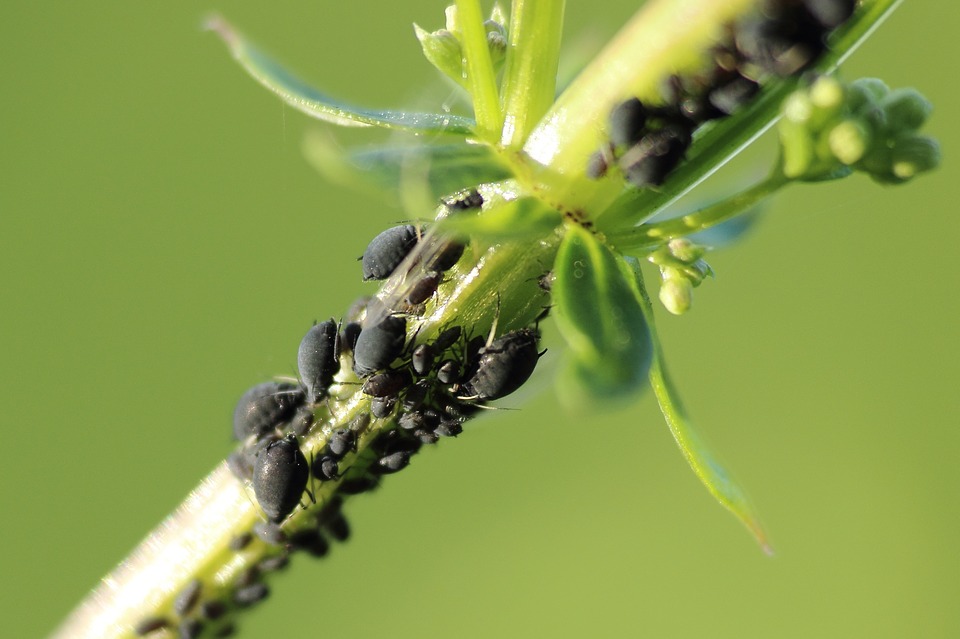
Tiny parasitic wasps are important natural enemies of aphids and, therefore, a farmer’s best friends. They are bred in great numbers and released in greenhouses to protect crops against aphid infestations. However, aphids have allies with whom they fight back. Some aphids carry symbiotic bacteria that make them resistant to parasitic wasps. These so-called defensive symbionts have the potential to compromise biological control, but clever breeding and release strategies might mitigate the problem.
Aphids, small plant sap-sucking insects, belong to the most important agricultural pests worldwide. They damage plants directly and they spread plant diseases, resulting in yield loss and huge economic damage. Chemical insecticides are used to limit this damage, but control efforts are frequently thwarted by the evolution of insecticide resistance. Alternative approaches to control aphids employ their natural enemies like predators or parasitic wasps, which works best in the confined spaces of greenhouses.
Small parasitic wasps, also referred to as parasitoids, are particularly well suited to combat aphids. They have a short generation time and a high fecundity, which is important to keep up with fast-reproducing hosts such as aphids. The lifestyle of parasitoids is fascinating, if morbid. Females attack aphids by injecting an egg, which develops into a larva that devours the live aphid from the inside. The larva grows almost as large as its host and eventually kills the aphid to pupate in a silky cocoon inside the aphid’s empty husk. This stage is called a “mummy.” Within days, a new wasp will emerge from the mummy, ready to attack more aphids.
With such formidable enemies, it is not surprising that the aphids have evolved defenses. More surprising is the nature of their most effective line of defense. Aphids often carry symbiotic bacteria inside their bodies, and these bacteria make them resistant to parasitoids by producing toxins that kill that parasitoid’s eggs or larvae [1]. These bacteria are heritable. They are passed on reliably from aphid mothers to their offspring. By protecting their hosts, the bacteria are, therefore, also protecting their own kind.
In the face of attack by parasitoids, aphids possessing such resistance-conferring symbionts should enjoy a significant advantage. Research on small-scale experimental systems (population cages) has shown that the application of parasitoids indeed favors symbiont-protected aphids very strongly. As a result, aphid populations become so resistant that they escape control by parasitoids [2]. This is not what farmers would like to see in their greenhouses.
At first glance, this effect is similar to the evolution of insecticide resistance. Unlike insecticides, however, parasitoids can evolve as well. Laboratory studies have demonstrated that parasitoid populations are capable of counter-adaptation. They can be selected to become better at overcoming the resistance conferred by the aphids’ symbionts [3]. This suggests ways in which biological control with parasitoids could be improved. One is to ensure that the parasitoids released in the crops possess sufficient genetic variation for rapid adaptation to symbiont-protected aphids.
A second improvement would be to use selective breeding, producing parasitoids that are pre-adapted to the presence of protective symbionts in their hosts. Another promising possibility is to combine parasitoid and predator applications: release parasitoids early to prevent the buildup of high aphid densities, and apply predators later to take out resistant aphids that escaped control by parasitoids. Clever, evidence-based strategies of pest control can thus help to address the challenge of symbiont-conferred resistance to parasitoids.
These findings are described in the article entitled Symbiont-conferred resistance to parasitoids in aphids – Challenges for biological control, recently published in the journal Biological Control. This work was conducted by Christoph Vorburger from Eawag and ETH Zürich, Switzerland.
References:
- Oliver, K.M., Degnan, P.H., Hunter, M.S., and Moran, N.A. (2009). Bacteriophages encode factors required for protection in a symbiotic mutualism. Science 325, 992-994.
- Käch, H., Mathé-Hubert, H., Dennis, A.B., and Vorburger, C. (2018). Rapid evolution of symbiont-mediated resistance compromises biological control of aphids by parasitoids. Evolutionary Applications 11, 220-230.
- Dennis, A.B., Patel, V., Oliver, K.M., and Vorburger, C. (2017). Parasitoid gene expression changes after adaptation to symbiont-protected hosts. Evolution 71, 2599-2617.









